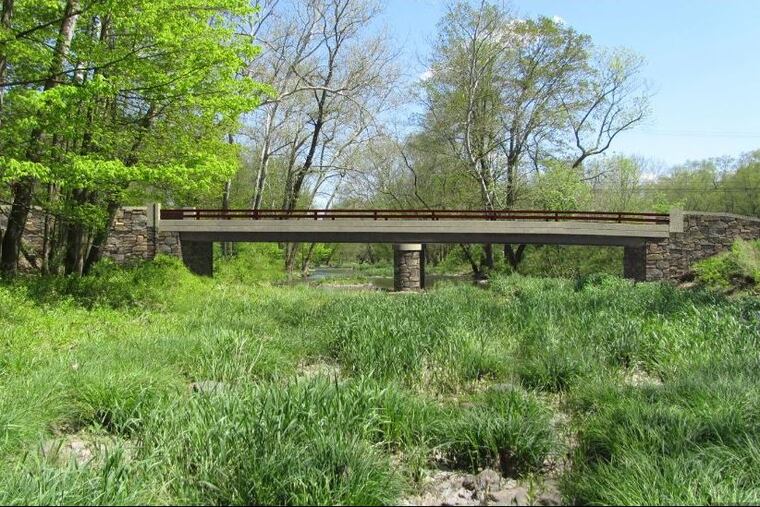Group sues to block replacement of 206-year-old stone bridge in Bucks County
Because of its poor condition, the Headquarters Road Bridge has been closed to traffic since 2011. Meanwhile, the state has been busy coming up with a replacement that calls for turning the current one-lane setup into two lanes.

The Headquarters Road Bridge has spanned Tinicum Creek in a bucolic slice of Bucks County since the War of 1812.
The Pennsylvania Department of Transportation has been seeking to replace its centuries-old stone foundation for more than a decade, because, it says, it's simply too old. So PennDot came up with plans for a modern bridge that seeks to keep the original character as much as possible.
But the Delaware Riverkeeper Network sued the state and Federal Highway Administration on Monday in federal court in an attempt to block the project, believing the bridge and its character can be preserved and re-opened for traffic. The group is a nonprofit dedicated to protecting the Delaware River watershed.
"The Tinicum Creek and Headquarters Road Bridge are beautiful and irreplaceable assets to Tinicum Township, Bucks County, and our wild and scenic Delaware River landscape," Maya van Rossum, leader of the Delaware Riverkeeper Network, said in a statement. "There is no defense for PennDot or the federal government's decision to destroy the bridge and inflict damage on the exceptional value of Tinicum Creek, especially when they are doing so in violation of the laws that are intended to help avoid such bad decision-making."
PennDot issued a statement saying the project not only received federal approval, but underwent 12 public meetings. The department considered 10 other alternatives before settling on the plan.
Because of its poor condition, the bridge has been closed to traffic since 2011. An inspection the following year found that "the overall condition of the bridge is serious, and that the structure, in its current state, is structurally deficient." The bridge once accommodated 900 vehicles per day, but that had dropped to 631 vehicles by the time it was closed. Because its lane is 16 feet wide, only one lane of traffic can pass at a time. Emergency vehicles can't fit at all.
As a result of the bridge's condition, which includes crumbling masonry, the state came up with a replacement plan that calls for turning the current one-lane setup into two lanes. That would mean ripping out the existing foundation and replacing it with a new base that includes stonework.
The bridge, also known as Burnt Mill Bridge or Sheephole Bridge, is the oldest "pier-to-pier" constructed bridge left in Pennsylvania and there is only one other left in the country, according to the complaint. Of eight remaining working bridges built in Pennsylvania before 1812, all were common stone arch construction.
The bridge is located where Headquarters and Sheep Hole Roads meet in Tinicum Township. Ottsville is on the west side and Erwinna is on the east side. It's about two miles as the crow files from the eastern edge of Nockamixon State Park. Some residents object to the years of detours caused by the bridge closure.
The Delaware Riverkeeper Network says the bridge should have been included in the National Register of Historic Places and that increasing vehicle traffic would have adverse environmental effects on the area, including sediment pollution from construction and alteration of the stream's flow.
It also said replacing the bridge will not only "adversely affect the ecotourism experience" of the Ridge Valley Rural Historic District that is listed in the National Register, but will take longer and be more expensive than rehabilitation.
The bridge was first opened to automobile traffic in 1919. Prior to that, it was used by pedestrians and horses. PennDot began scoping out how to replace the bridge since 2002 and held its first public meeting in 2005. The bridge continued to deteriorate and its load limit was reduced before it was closed.
The Riverkeeper Network began asking that the bridge be rehabilitated and considered "an irreplaceable historic and environmental resource." It hired its own experts to show it was possible to keep the bridge's original masonry.
The court complaint, filed in U.S. District Court in Philadelphia, says that PennDot's plan is in violation of environmental regulations and moved ahead "a predetermined outcome in mind: replacement of the bridge" without seriously considering alternatives. It seeks a court order to stop construction.
The Riverkeeper Network has offered its own plan by McMullan &Associates that calls for replacing the top deck and guardrails of the nearly 80-foot-long bridge. It would also preserve the original masonry piers and abutments.
PennDot's statement said that the degree of analysis it undertook was "unprecedented" for such a project. It does not agree with the Riverkeeper that a rehabilitated bridge would meet "the needs of the community" and would "be a wise investment of taxpayer dollars."